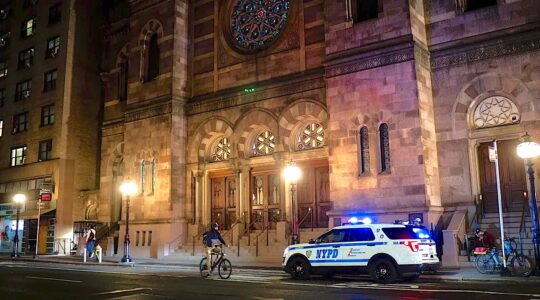When he was a sophomore at Drexel University in Philadelphia and an active member of the campus’ Hillel chapter, Arnold Lustiger spotted a notice about an upcoming Jewish lecture at the nearby University of Pennsylvania in 1975.
He had not heard of that night’s speaker, Rabbi Joseph Ber Soloveitchik, the venerated head of Yeshiva University’s rabbinical seminary, and was not planning to attend.
Then, a Hillel director, who had attended YU, suggested that Lustiger go to the lecture. As a graduate of a black-hat Orthodox day school who is interested in advanced Jewish learning, the director said, “You’re crazy if you don’t go.”
“I had no expectations,” but “it was life-changing,” Lustiger told The Jewish Week. “It opened up an entire new world to me.”
Lustiger, 65, is a resident of Edison, N.J., who works as a senior research scientist for ExxonMobil, specializing in the properties of plastics. He said the lecture lasted “a good three hours,” during which the rabbi ranged from the minutia of halacha to esoteric philosophy and psychology. “I had never heard anything remotely like it. There was a charisma to him. … You were drawn to his words.”
Rabbi Soloveitchik is the Belarus-born scion of a prominent rabbinic family who was recognized as the philosophical leader of the Modern Orthodox movement and known simply as “The Rav” (The Rabbi) in those Religious Zionist circles. In the lecture he presented an integrated approach to understanding fundamental Jewish beliefs that was new to Lustiger, he said. Combining classical Jewish sources with current events and observations on secular culture, the lecture opened Lustiger’s eyes, he said, to a new way of understanding Torah, studying text and practicing as an observant Jew.
That night led Lustiger on a years-long journey to flesh out the insights of that initial lecture. He began attending more of the rabbi’s lectures and speeches, and read all of the handful of books that Rabbi Soloveitchik had written. He tracked down the rabbi’s cited sources and located a fellow disciple of the Rav who had collected tapes of all of Rabbi Soloveitchik’s public lectures. He bought a copy of the entire collection, edited the lectures, including translating the Yiddish parts, and compiled the rabbi’s erudite spoken thoughts and written essays into five books. And over the last dozen years, he has edited Rabbi Soloveitchik’s remarks about the Five Books of Moses, largely delivered as part of lectures on Talmud and other Jewish topics at public forums and rabbinical conferences, into the rabbi’s first-ever Torah commentary.
Rabbi Soloveitchik, who lived in Boston, retired in 1985 and died in 1993 at 90, never wrote a systematic commentary on the Torah.
Lustiger set out to bring Rabbi Soloveitchik’s largely oral legacy to the printed page. He had already brought out commentaries on the siddur, and the High Holy Days liturgy, based on The Rav’s words.
The fifth and final volume of Chumash Mesoras HaRav (OU Press), a Torah commentary, has just appeared. The book follows in the tradition of scholars who in recent decades have collated and collected the works of earlier prominent rabbis on subjects related to Passover, publishing them as Haggadah commentaries; Lustiger has shaped The Rav’s disparate insights on various areas of Torah into a comprehensive work, arranged according to the Torah’s 54 weekly parshiot. (Chumash, Hebrew for five, is how the first five books of Jewish scripture are commonly known.)
The “Neuwirth Edition” of the commentary bears the name of the philanthropic Neuwirth family, who financially supported the publishing project.
On each page the book features the Torah’s Hebrew text and the Hebrew-language translation-cum-commentary of Onkelos, the standard Chumash commentary of Rashi in Hebrew, and Rabbi Soloveitchik’s words in English.
Support the New York Jewish Week
Our nonprofit newsroom depends on readers like you. Make a donation now to support independent Jewish journalism in New York.
The rabbi’s commentary succinctly explains the meaning of Torah passages, often in ways not obvious to the casual reader. On Joseph’s encounter with his brothers, while he was serving as viceroy in Egypt — “Joseph recognized his brothers” (Genesis 42:8), in parshat Miketz — Rabbi Soloveitchik states, “Although his brothers thought they had come to Egypt to procure food, Joseph ‘recognized’ the subtext of their visit. Their arrival was the first step in the fulfillment of the great Divine plan” — that God had revealed to the Patriarch Abraham.
“The Rav methodically and clearly developed a central thesis” on each theme he was discussing, Lustiger writes in the introduction. “He buttressed this key idea meticulously through a series of questions and answers. … Ultimately, at the end of his presentation, he had built a dazzling and impenetrable edifice.”
As an example of Rabbi Soloveitchik’s expansive technique, Lustiger pointed to the Rav’s comments on the introduction to the Ten Commandments (Exodus 20:1): “God spoke all these words, saying …” Seven words in Hebrew.
Lustiger reproduces in an appendix a lengthy lecture on these apparently prosaic words that Rabbi Soloveitchik delivered in June 1972. The contents could not be boiled down to a few paragraphs, Lustiger said. “It was brilliant.” Typical of The Rav’s style, he took words that appear not to be distinctive in the Torah, which are usually overshadowed by the subsequent listing of commandments, and cast them in a new light, Lustiger said.
The series, which spans from Genesis to Deuteronomy, he said, is designed to introduce Rabbi Soloveitchik — and his unique method of explaining Torah — to generations of Jews who never had the chance to listen to The Rav’s speeches in person or on a recording. It is likely to become a classic, an easily accessible commentary along the lines of the Soncino “Hertz Chumash” and ArtScroll’s “Stone Edition Chumash,” which have become the standard for at-home study or reading along with the Torah chanting in synagogue.
Lustiger devoted an hour or two each day after work to his project, also listening to The Rav’s recorded speeches while driving to work. “I didn’t go to many parties,” he said.
Why, in this high-tech, Kindle era of easily discarded ideas, spend all the time and energy on a figure who died a quarter-century ago?
“There is a tremendous reverence” — in the Orthodox community and among outsiders with an interest in Torah study — for gedolim [literally, “the great ones”],” respected leaders whose deeds of piety matched their academic accomplishments, Lustiger answered.
Lustiger said his training as an empirically oriented scientist complements his understanding of Rabbi Soloveitchik’s breadth of Torah and secular knowledge. Just as scientific principles are not simply a series of theories, but a “way of thinking,” the same applies to halacha, Jewish law, he said.
Ironically, Lustiger, who now ranks as one of the ranking experts on The Rav’s life, never had a face-to-face encounter with Rabbi Soloveitchik. “I never spoke with him.”
Lustiger is now at work on bringing to the public a major lecture The Rav delivered on aspects of repentance.
Though Rabbi Soloveitchik was a public figure, he was also self-effacing; he wrote few books, Lustiger said. The Rav’s family, recognizing the importance of continuing to disseminate the rabbi’s teachings, has given his work their blessing, Lustiger said. “They appreciate people hearing The Rav.”
Support the New York Jewish Week
Our nonprofit newsroom depends on readers like you. Make a donation now to support independent Jewish journalism in New York.
By what measure will Lustiger consider his Rabbi Soloveitchik Torah commentary a success?
If the commentary sparks readers’ interest in The Rav, he said. “If they say, ‘I want to read more.’”
Lustiger said his ultimate goal is to make people feel the excitement he felt when he first heard Rabbi Soloveitchik in 1975. “I want people to reproduce my experience,” he said.
The New York Jewish Week brings you the stories behind the headlines, keeping you connected to Jewish life in New York. Help sustain the reporting you trust by donating today.




